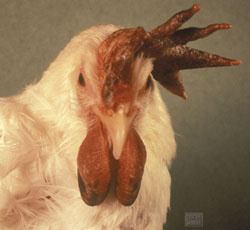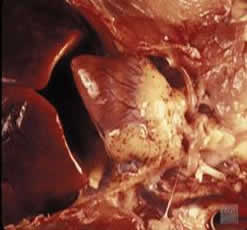| Avian Influenza | ||
Avian influenza viruses, can kill up to 90-100% of a poultry flock. Epidemics of high pathogenicity avian influenza can spread rapidly, devastate the poultry industry and result in severe trade restrictions. Etiology Avian influenza results from infection by viruses in the influenzavirus A genus and influenza A species of the family Orthomyxoviridae. These viruses are also called type A influenza viruses. In addition to avian influenza viruses, this species includes the closely related human, equine, swine and canine influenza viruses. Influenza A viruses are classified into subtypes based on two surface antigens, the hemagglutinin (H) and neuraminidase (N) proteins. There are 16 hemagglutinin antigens (H1 to H16) and nine neuraminidase antigens (N1 to N9). The most virulent strain of these viruses is H5N1. Transmission In birds, avian influenza viruses are shed in the feces as well as in saliva and nasal secretions. The feces contain large amounts of virus, and fecal-oral transmission is usually the predominant means of spread in wild bird reservoirs. Some recent isolates of Asian lineage H5N1 (HPAI) viruses have been found in higher quantities in respiratory secretions than the feces. This suggests that, at least in some wild birds, these strains may no longer be transmitted primarily by the fecal-oral route. Infections in Humans Incubation Period Asian lineage H5N1 infections suggest that the incubation period for this virus may range from two to eight days and could be as long as 17 days. In most cases, the first symptoms appear in two to five days. The World Health Organization (WHO) currently suggests using an incubation period of seven days for field investigations and monitoring patient contacts. Clinical Signs High fever and upper respiratory symptoms resembling human seasonal influenza tend to be the initial signs. In some patients, there may also be mucosal bleeding, or gastrointestinal symptoms such as diarrhea, vomiting and abdominal pain. Birds Avian influenza viruses mainly infect birds. In wild species, these viruses are especially common among birds that live in wetlands and other aquatic environments. Important reservoir hosts include ducks, geese, swans, gulls, terns and waders. H5N1 isolates have caused severe, acute disease with neurological signs and high mortality rates.
Treatment Four antiviral drugs -- amantadine, rimantadine, zanamivir, and oseltamivir - are active against human influenza viruses. Studies suggest that these drugs may also be helpful in avian influenza infections in humans. |
||
References:
|




